Chaoyun Zhang
SWE-bench Goes Live!
May 29, 2025Abstract:The issue-resolving task, where a model generates patches to fix real-world bugs, has emerged as a critical benchmark for evaluating the capabilities of large language models (LLMs). While SWE-bench and its variants have become standard in this domain, they suffer from key limitations: they have not been updated since their initial releases, cover a narrow set of repositories, and depend heavily on manual effort for instance construction and environment setup. These factors hinder scalability and introduce risks of overfitting and data contamination. In this work, we present \textbf{SWE-bench-Live}, a \textit{live-updatable} benchmark designed to overcome these challenges. Our initial release consists of 1,319 tasks derived from real GitHub issues created since 2024, spanning 93 repositories. Each task is accompanied by a dedicated Docker image to ensure reproducible execution. Central to our benchmark is \method, an automated curation pipeline that streamlines the entire process from instance creation to environment setup, removing manual bottlenecks and enabling scalability and continuous updates. We evaluate a range of state-of-the-art agent frameworks and LLMs on SWE-bench-Live, revealing a substantial performance gap compared to static benchmarks like SWE-bench, even under controlled evaluation conditions. To better understand this discrepancy, we perform detailed analyses across repository origin, issue recency, and task difficulty. By providing a fresh, diverse, and executable benchmark grounded in live repository activity, SWE-bench-Live facilitates rigorous, contamination-resistant evaluation of LLMs and agents in dynamic, real-world software development settings.
Text2Grad: Reinforcement Learning from Natural Language Feedback
May 28, 2025Abstract:Traditional RLHF optimizes language models with coarse, scalar rewards that mask the fine-grained reasons behind success or failure, leading to slow and opaque learning. Recent work augments RL with textual critiques through prompting or reflection, improving interpretability but leaving model parameters untouched. We introduce Text2Grad, a reinforcement-learning paradigm that turns free-form textual feedback into span-level gradients. Given human (or programmatic) critiques, Text2Grad aligns each feedback phrase with the relevant token spans, converts these alignments into differentiable reward signals, and performs gradient updates that directly refine the offending portions of the model's policy. This yields precise, feedback-conditioned adjustments instead of global nudges. Text2Grad is realized through three components: (1) a high-quality feedback-annotation pipeline that pairs critiques with token spans; (2) a fine-grained reward model that predicts span-level reward on answer while generating explanatory critiques; and (3) a span-level policy optimizer that back-propagates natural-language gradients. Across summarization, code generation, and question answering, Text2Grad consistently surpasses scalar-reward RL and prompt-only baselines, providing both higher task metrics and richer interpretability. Our results demonstrate that natural-language feedback, when converted to gradients, is a powerful signal for fine-grained policy optimization. The code for our method is available at https://github.com/microsoft/Text2Grad
Zoomer: Adaptive Image Focus Optimization for Black-box MLLM
Apr 30, 2025Abstract:Recent advancements in multimodal large language models (MLLMs) have broadened the scope of vision-language tasks, excelling in applications like image captioning and interactive question-answering. However, these models struggle with accurately processing visual data, particularly in tasks requiring precise object recognition and fine visual details. Stringent token limits often result in the omission of critical information, hampering performance. To address these limitations, we introduce \SysName, a novel visual prompting mechanism designed to enhance MLLM performance while preserving essential visual details within token limits. \SysName features three key innovations: a prompt-aware strategy that dynamically highlights relevant image regions, a spatial-preserving orchestration schema that maintains object integrity, and a budget-aware prompting method that balances global context with crucial visual details. Comprehensive evaluations across multiple datasets demonstrate that \SysName consistently outperforms baseline methods, achieving up to a $26.9\%$ improvement in accuracy while significantly reducing token consumption.
UFO2: The Desktop AgentOS
Apr 20, 2025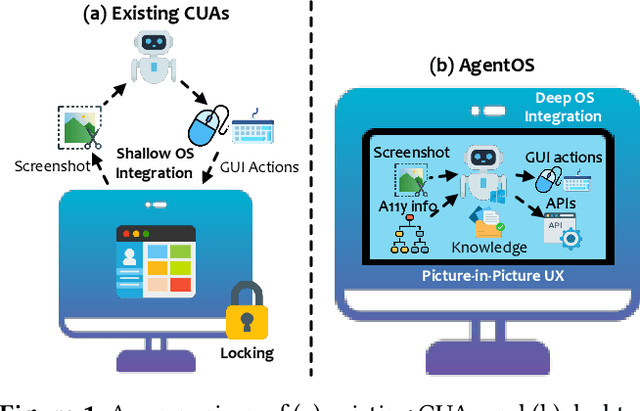
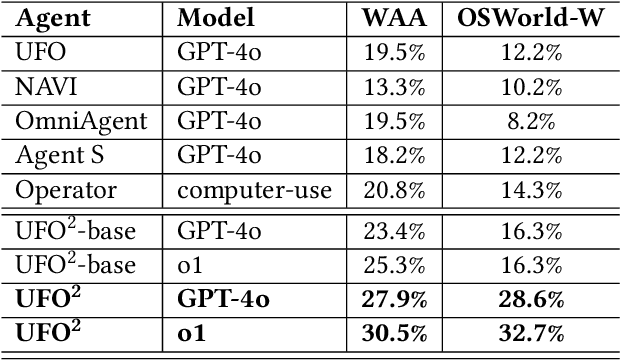
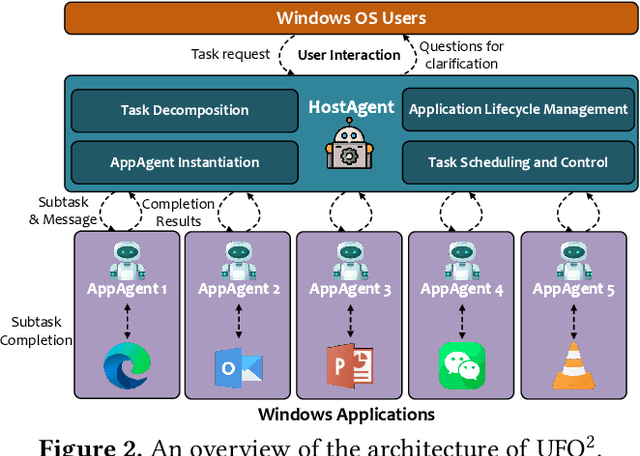

Abstract:Recent Computer-Using Agents (CUAs), powered by multimodal large language models (LLMs), offer a promising direction for automating complex desktop workflows through natural language. However, most existing CUAs remain conceptual prototypes, hindered by shallow OS integration, fragile screenshot-based interaction, and disruptive execution. We present UFO2, a multiagent AgentOS for Windows desktops that elevates CUAs into practical, system-level automation. UFO2 features a centralized HostAgent for task decomposition and coordination, alongside a collection of application-specialized AppAgent equipped with native APIs, domain-specific knowledge, and a unified GUI--API action layer. This architecture enables robust task execution while preserving modularity and extensibility. A hybrid control detection pipeline fuses Windows UI Automation (UIA) with vision-based parsing to support diverse interface styles. Runtime efficiency is further enhanced through speculative multi-action planning, reducing per-step LLM overhead. Finally, a Picture-in-Picture (PiP) interface enables automation within an isolated virtual desktop, allowing agents and users to operate concurrently without interference. We evaluate UFO2 across over 20 real-world Windows applications, demonstrating substantial improvements in robustness and execution accuracy over prior CUAs. Our results show that deep OS integration unlocks a scalable path toward reliable, user-aligned desktop automation.
API Agents vs. GUI Agents: Divergence and Convergence
Mar 14, 2025Abstract:Large language models (LLMs) have evolved beyond simple text generation to power software agents that directly translate natural language commands into tangible actions. While API-based LLM agents initially rose to prominence for their robust automation capabilities and seamless integration with programmatic endpoints, recent progress in multimodal LLM research has enabled GUI-based LLM agents that interact with graphical user interfaces in a human-like manner. Although these two paradigms share the goal of enabling LLM-driven task automation, they diverge significantly in architectural complexity, development workflows, and user interaction models. This paper presents the first comprehensive comparative study of API-based and GUI-based LLM agents, systematically analyzing their divergence and potential convergence. We examine key dimensions and highlight scenarios in which hybrid approaches can harness their complementary strengths. By proposing clear decision criteria and illustrating practical use cases, we aim to guide practitioners and researchers in selecting, combining, or transitioning between these paradigms. Ultimately, we indicate that continuing innovations in LLM-based automation are poised to blur the lines between API- and GUI-driven agents, paving the way for more flexible, adaptive solutions in a wide range of real-world applications.
VEM: Environment-Free Exploration for Training GUI Agent with Value Environment Model
Feb 26, 2025Abstract:Training Vision-Language Models (VLMs) for Graphical User Interfaces (GUI) agents via Reinforcement Learning (RL) faces critical challenges: environment-based RL requires costly interactions, while environment-free methods struggle with distribution shift and reward generalization. We propose an environment-free RL framework that decouples value estimation from policy optimization by leveraging a pretrained Value Environment Model (VEM). VEM predicts state-action values directly from offline data, distilling human-like priors about GUI interaction outcomes without requiring next-state prediction or environmental feedback. This avoids compounding errors and enhances resilience to UI changes by focusing on semantic reasoning (e.g., Does this action advance the user's goal?). The framework operates in two stages: (1) pretraining VEM to estimate long-term action utilities and (2) guiding policy exploration with frozen VEM signals, enabling layout-agnostic GUI automation. Evaluated on Android-in-the-Wild benchmarks, VEM achieves state-of-the-art performance in both offline and online settings, outperforming environment-free baselines significantly and matching environment-based approaches without interaction costs. Importantly, VEM demonstrates that semantic-aware value estimation can achieve comparable performance with online-trained methods.
DI-BENCH: Benchmarking Large Language Models on Dependency Inference with Testable Repositories at Scale
Jan 23, 2025Abstract:Large Language Models have advanced automated software development, however, it remains a challenge to correctly infer dependencies, namely, identifying the internal components and external packages required for a repository to successfully run. Existing studies highlight that dependency-related issues cause over 40\% of observed runtime errors on the generated repository. To address this, we introduce DI-BENCH, a large-scale benchmark and evaluation framework specifically designed to assess LLMs' capability on dependency inference. The benchmark features 581 repositories with testing environments across Python, C#, Rust, and JavaScript. Extensive experiments with textual and execution-based metrics reveal that the current best-performing model achieves only a 42.9% execution pass rate, indicating significant room for improvement. DI-BENCH establishes a new viewpoint for evaluating LLM performance on repositories, paving the way for more robust end-to-end software synthesis.
Large Action Models: From Inception to Implementation
Dec 13, 2024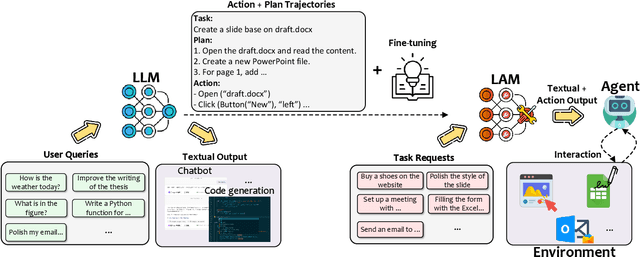

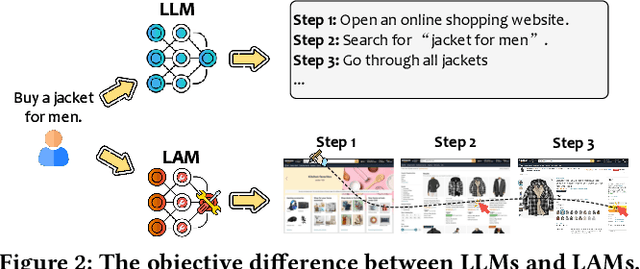

Abstract:As AI continues to advance, there is a growing demand for systems that go beyond language-based assistance and move toward intelligent agents capable of performing real-world actions. This evolution requires the transition from traditional Large Language Models (LLMs), which excel at generating textual responses, to Large Action Models (LAMs), designed for action generation and execution within dynamic environments. Enabled by agent systems, LAMs hold the potential to transform AI from passive language understanding to active task completion, marking a significant milestone in the progression toward artificial general intelligence. In this paper, we present a comprehensive framework for developing LAMs, offering a systematic approach to their creation, from inception to deployment. We begin with an overview of LAMs, highlighting their unique characteristics and delineating their differences from LLMs. Using a Windows OS-based agent as a case study, we provide a detailed, step-by-step guide on the key stages of LAM development, including data collection, model training, environment integration, grounding, and evaluation. This generalizable workflow can serve as a blueprint for creating functional LAMs in various application domains. We conclude by identifying the current limitations of LAMs and discussing directions for future research and industrial deployment, emphasizing the challenges and opportunities that lie ahead in realizing the full potential of LAMs in real-world applications. The code for the data collection process utilized in this paper is publicly available at: https://github.com/microsoft/UFO/tree/main/dataflow, and comprehensive documentation can be found at https://microsoft.github.io/UFO/dataflow/overview/.
Large Language Model-Brained GUI Agents: A Survey
Dec 03, 2024



Abstract:GUIs have long been central to human-computer interaction, providing an intuitive and visually-driven way to access and interact with digital systems. The advent of LLMs, particularly multimodal models, has ushered in a new era of GUI automation. They have demonstrated exceptional capabilities in natural language understanding, code generation, and visual processing. This has paved the way for a new generation of LLM-brained GUI agents capable of interpreting complex GUI elements and autonomously executing actions based on natural language instructions. These agents represent a paradigm shift, enabling users to perform intricate, multi-step tasks through simple conversational commands. Their applications span across web navigation, mobile app interactions, and desktop automation, offering a transformative user experience that revolutionizes how individuals interact with software. This emerging field is rapidly advancing, with significant progress in both research and industry. To provide a structured understanding of this trend, this paper presents a comprehensive survey of LLM-brained GUI agents, exploring their historical evolution, core components, and advanced techniques. We address research questions such as existing GUI agent frameworks, the collection and utilization of data for training specialized GUI agents, the development of large action models tailored for GUI tasks, and the evaluation metrics and benchmarks necessary to assess their effectiveness. Additionally, we examine emerging applications powered by these agents. Through a detailed analysis, this survey identifies key research gaps and outlines a roadmap for future advancements in the field. By consolidating foundational knowledge and state-of-the-art developments, this work aims to guide both researchers and practitioners in overcoming challenges and unlocking the full potential of LLM-brained GUI agents.
RuAG: Learned-rule-augmented Generation for Large Language Models
Nov 04, 2024



Abstract:In-context learning (ICL) and Retrieval-Augmented Generation (RAG) have gained attention for their ability to enhance LLMs' reasoning by incorporating external knowledge but suffer from limited contextual window size, leading to insufficient information injection. To this end, we propose a novel framework, RuAG, to automatically distill large volumes of offline data into interpretable first-order logic rules, which are injected into LLMs to boost their reasoning capabilities. Our method begins by formulating the search process relying on LLMs' commonsense, where LLMs automatically define head and body predicates. Then, RuAG applies Monte Carlo Tree Search (MCTS) to address the combinational searching space and efficiently discover logic rules from data. The resulting logic rules are translated into natural language, allowing targeted knowledge injection and seamless integration into LLM prompts for LLM's downstream task reasoning. We evaluate our framework on public and private industrial tasks, including natural language processing, time-series, decision-making, and industrial tasks, demonstrating its effectiveness in enhancing LLM's capability over diverse tasks.
 Add to Chrome
Add to Chrome Add to Firefox
Add to Firefox Add to Edge
Add to Edge